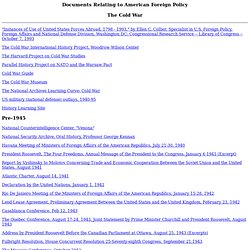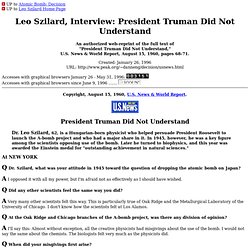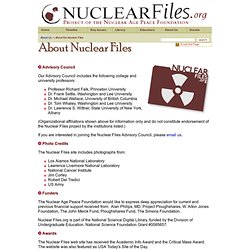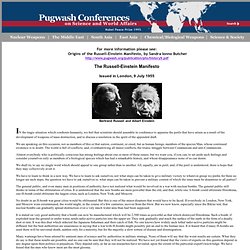

Documents Related to the Cold War. Documents Relating to American Foreign Policy The Cold War "Instances of Use of United States Forces Abroad, 1798 - 1993," by Ellen C.

Collier, Specialist in U.S. Foreign Policy, Foreign Affairs and National Defense Division, Washington DC: Congressional Research Service -- Library of Congress -- October 7, 1993. National Archives and Records Administration. Mount Holyoke College. 91144: Nuclear Weapons in the Former Soviet Union: Location, Command, and Control. Congressional Research Service Reports 91144: Nuclear Weapons in the Former Soviet Union: Location, Command, and Control Updated November 27, 1996 Amy F.

Woolf Foreign Affairs and National Defense Division. Leo Szilard, Interview: President Truman Did Not Understand. UP to Atomic Bomb: Decision UP to Leo Szilard Home Page An authorized web-reprint of the full text of "President Truman Did Not Understand," U.S.

ATOMIC BOMB: DECISION (Hiroshima-Nagasaki) Nuclear Files: About Us: About the Nuclear Files. Advisory Council Our Advisory Council includes the following college and university professors: Professor Richard Falk, Princeton University Dr.

Frank Settle, Washington and Lee University Dr. Michael Wallace, University of British Columbia Dr. Tom Whaley, Washington and Lee University Dr. (Organizational affiliations shown above for information only and do not constitute endorsement of the Nuclear Files project by the institutions listed.) Continental Defense in the Eisenhower Era: Nuclear Antiaircraft Arms and the Cold War. Fueled by Cold War anxiety about the threat of a surprise nuclear attack by Soviet jet-bombers, the U.S. nuclear arsenal ballooned from 841 warheads when President Eisenhower assumed office in 1953 to over 18,000 by the time he left office in 1961.

Roughly 20% of these warheads were based around cities and military installations throughout the U.S. for air defense purposes. The fact that the widely publicized deployment of over 3,500 nuclear weapons explicitly intended for use directly over or near U.S. territory enjoyed broad public support is a telling measure of early Cold War fears, according to Christopher Bright, author of Continental Defense in the Eisenhower Era: Nuclear Antiaircraft Arms and the Cold War. Significant support for the development and deployment of nuclear anti-aircraft arms came from Robert Sprague, a New England industrialist, top Eisenhower advisor on air defense issues, and key contributor to the 1955 Killian Commission Report on U.S. military capabilities.
Search. The National Archives Learning Curve. Documents Related to the Cold War. The Nuclear Arms Race. The nuclear arms race was central to the Cold War.

Many feared where the Cold War was going with the belief that the more nuclear weapons you had, the more powerful you were. Both America and Russia massively built up their stockpiles of nuclear weapons. The world greatly changed when USA exploded the H-bomb in 1952. This one bomb was smaller in size than the Hiroshima atomic bomb but 2500 times more powerful. The Russians produced an H-bomb in 1953 and the world became a much more dangerous place. The Nuclear Winter. Manifiesto Russell-Einstein, una declaración sobre armas nucleares, Londres 9 de julio de 1955. Russell-Einstein Manifesto. For more information please see: Origins of the Russell-Einstein Manifesto, by Sandra Ionno Butcher The Russell-Einstein Manifesto Issued in London, 9 July 1955 Bertrand Russell and Albert Einstein IN the tragic situation which confronts humanity, we feel that scientists should assemble in conference to appraise the perils that have arisen as a result of the development of weapons of mass destruction, and to discuss a resolution in the spirit of the appended draft.

We are speaking on this occasion, not as members of this or that nation, continent, or creed, but as human beings, members of the species Man, whose continued existence is in doubt. Almost everybody who is politically conscious has strong feelings about one or more of these issues; but we want you, if you can, to set aside such feelings and consider yourselves only as members of a biological species which has had a remarkable history, and whose disappearance none of us can desire. We have to learn to think in a new way. Max Born. Continental Defense in the Eisenhower Era: Nuclear Antiaircraft Arms and the Cold War. Us_nuclear_arsenal_2010. CRS-StrategicNuclearForcesReport_Amy_Woolf. Nuclear Files - From nuclear proliferation to nuclear testing, from Hiroshima to North Korea, Nuclear Files offers the A to Z on nuclear issues. Cold War Museum.
Woodrow Wilson International Center for Scholars. An Error Occurred Setting Your User Cookie. JSTOR. Carl von Clausewitz. Name[edit] Clausewitz's Christian names are sometimes given in non-German sources as "Carl Philipp Gottlieb" or "Carl Maria.

" He spelled his own given name with a "C" in order to identify with the classical Western tradition; writers who use "Karl" are often seeking to emphasize his German (rather than European) identity. "Carl Philipp Gottfried" appears on Clausewitz's tombstone.[4] Nonetheless, reputable Clausewitz experts such as Peter Paret and sources such as Encyclopædia Britannica still use Gottlieb instead of Gottfried, presumably based on their reading of handwritten birth records.[5] Life and military career[edit] Clausewitz was born on June 1, 1780 in Burg bei Magdeburg, Prussia, the fourth and youngest son of a middle-class family.
Clausewitz served during the Jena Campaign as aide-de-camp to Prince August. Marie von Clausewitz (née, Countess von Brühl) An Error Occurred Setting Your User Cookie. The Cuban Missile Crisis, 1962: Chronologies of the Crisis.